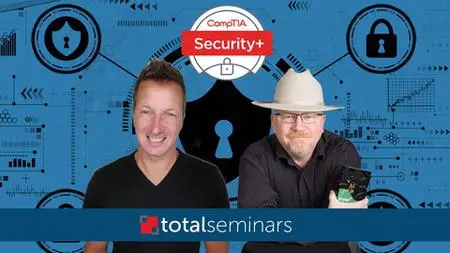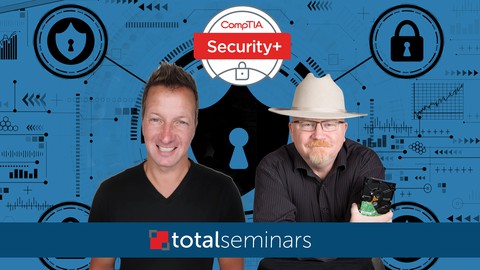Total: Comptia Security+ Certification (Sy0-601)
Last updated 6/2022
MP4 | Video: h264, 1280x720 | Audio: AAC, 44.1 KHz
Language: English | Size: 20.59 GB | Duration: 19h 33m
Last updated 6/2022
MP4 | Video: h264, 1280x720 | Audio: AAC, 44.1 KHz
Language: English | Size: 20.59 GB | Duration: 19h 33m
Everything you need to pass the CompTIA Security+ (SY0-601) exam from Mike Meyers and Dan Lachance
What you'll learn
This is a complete and comprehensive CompTIA Security+ Certification (SY0-601) course. It is designed to prepare you to take and pass the CompTIA exam
You will have the knowledge and confidence to pass the CompTIA exam AND the skills to be a great IT security tech.
Your new skills and the CompTIA Security+ Cert will help you land a great IT security tech job or, get that raise or advancement you are after.
This course is ideal as both a study tool and an on-the-job reference for IT Security tasks.
Requirements
Basic familiarity with PCs and networks.
There are no specific prerequisites, since the course covers all the topics in detail.
It is a good idea to have an understanding of CompTIA A+ and Network+, or to be certified in these topics. You can learn more about these certifications from our Mike Meyers – Total Seminars CompTIA A+ and Network+ Certification courses on Udemy.
Description
Welcome to the TOTAL: CompTIA Security+ Certification (SY0-601), a course from the production studios of Total Seminars with subject matter experts Mike Meyers and Dan Lachance.This course covers everything you need to know to pass your CompTIA Security+ (SY0-601) certification exam. With over 17 hours of in-depth and fascinating content and 125 video lectures, this course will not only make you a good IT security tech, but make sure you are ready to pass the CompTIA Security+ exam. Mike Meyers is the President of Total Seminars and well known as the "Alpha Geek". Mike is widely known at the #1 CompTIA author and instructor with over 1 million books in print. Dan Lachance is a highly motivated and passionate IT evangelist. He is a consultant, trainer, and author with over 20 years of experience in the IT security industry.This course shows you how to:Apply the three “A’s” of security: authentication, authorization, and accountingScan your wired or wireless network and assess it for various weaknessesUse cryptography to assure integrity of data through hashing and confidentiality of data through symmetric/asymmetric cryptosystems and public key infrastructure (PKI)Understand critical concepts in risk management, like setting up alerts, responding to incidents, and mitigating vulnerabilitiesIdentify how hackers are trying to get into your network, IT infrastructure, and physical assets and how security techs help prevent those breachesPrevent attacks ranging from simple malware to sophisticated exploits to social engineering that takes advantage of people’s trust, relationships, and lack of knowledgeApply the techniques used in penetration testing, including passive and active reconnaissanceSecure an enterprise environment, including creating incident response, business continuity, and disaster recovery plansWHY SHOULD I TAKE THIS COURSE?Total Seminars has an excellent reputation in the IT training industry, offering a wide variety of training tools. This course’s subject matter experts, Mike Meyers and Dan Lachance, have a combined 50+ years of experience. Mike has created training materials for thousands of schools, corporations, and government agencies, and has taught numerous seminars for the FBI, DEA, and many other corporate partners; he also wrote several bestselling CompTIA certification guides. Dan is the owner of Lachance IT Consulting, Inc. and has taught many online IT training courses in addition to his work as a network and server consultant and IT security auditor.This course will also prepare you for the CompTIA Security+ exam, which is industry standard certification, compliant with ISO 17024 standards, accredited by ANSI, and approved by the U.S. Department of Defense.The average beginner IT security salary is $74,000, and an information security analyst can make a much as is $117,000 starting out. If you’re looking to advance your career, this certification is a great place to start. 96% of HR managers use IT certifications as screening or hiring criteria during recruitment.WHAT’S COVERED?The course covers all the CompTIA Security+ (SY0-601) objective domains:Threats, Attacks, and Vulnerabilities (24%)Architecture and Design (21%)Implementation (25%)Operations and Incident Response (16%)Governance, Risk, and Compliance (14%)EXAM INFOExam code: SY0-601Max. 90 questions (performance-based and multiple choice)Length of exam: 90 minutesPassing score: 750 (on a scale of 100-900)Exam voucher cost: $349 USD (be sure to go to Total Seminars' website for discount vouchers!)Recommended experience: CompTIA Network+ and two years of experience in IT administration with a security focusTesting provider: Pearson VUE (in-person and online at-home options available)HOW DO I TAKE THE COMPTIA SECURITY+ EXAM?Buy an exam voucher (get your discount voucher at Total Seminars' website), schedule your exam on the Pearson VUE Web site, then take the exam at a qualifying Pearson VUE testing center or virtually using their OnVue option.Schedule through a testing center: pearsonvue. comSchedule an at-home (or at-work) exam: onvue. comWHAT KIND OF JOB CAN I GET WITH A COMPTIA SECURITY+ CERTIFICATION?Security or systems administratorSecurity engineer/analystSecurity IT auditorIT project managerBeginner cybersecurity specialistJunior IT auditorJunior penetration tester
Overview
Section 1: Introduction
Lecture 1 Introduction to CompTIA Security+ SY0-601
Lecture 2 About the CompTIA Security+ SY0-601 Exam
Section 2: Chapter 1: Risk Management
Lecture 3 Defining Risk
Lecture 4 Threats and Vulnerabilities
Lecture 5 Threat Intelligence
Lecture 6 Risk Management Concepts
Lecture 7 Security Controls
Lecture 8 Risk Assessments and Treatments
Lecture 9 Quantitative Risk Assessments
Lecture 10 Qualitative Risk Assessments
Lecture 11 Business Impact Analysis
Lecture 12 Data Types and Roles
Lecture 13 Security and the Information Life Cycle
Lecture 14 Data Destruction
Lecture 15 Personnel Risk and Policies
Lecture 16 Third-Party Risk Management
Lecture 17 Agreement Types
Lecture 18 Chapter 1 Exam Question Review
Lecture 19 Wiping Disks with the dd Command Lab
Lecture 20 Chapter 1 Ask Me Anything (AMA)
Section 3: Chapter 2: Cryptography
Lecture 21 Cryptography Basics
Lecture 22 Data Protection
Lecture 23 Cryptographic Methods
Lecture 24 Symmetric Cryptosystems
Lecture 25 Symmetric Block Modes
Lecture 26 Asymmetric Cryptosystems
Lecture 27 Diffie-Hellman
Lecture 28 Hashing
Lecture 29 Understanding Digital Certificates
Lecture 30 Trust Models
Lecture 31 Public Key Infrastructure
Lecture 32 Certificate Types
Lecture 33 Touring Certificates
Lecture 34 Cryptographic Attacks
Lecture 35 Password Cracking
Lecture 36 Password Cracking Demo
Lecture 37 Chapter 2 Exam Question Review
Lecture 38 SSH Public Key Authentication Lab
Lecture 39 Chapter 2 Ask Me Anything (AMA)
Section 4: Chapter 3: Identity and Account Management
Lecture 40 Identification, Authentication, and Authorization
Lecture 41 Enabling Multifactor Authentication
Lecture 42 Authorization
Lecture 43 Accounting
Lecture 44 Authentication Methods
Lecture 45 Access Control Schemes
Lecture 46 Account Management
Lecture 47 Network Authentication
Lecture 48 Identity Management Systems
Lecture 49 Chapter 3 Exam Question Review
Lecture 50 Creating LInux Users and Groups Lab
Lecture 51 Chapter 3 Ask Me Anything (AMA)
Section 5: Chapter 4: Tools of the Trade
Lecture 52 Touring the CLI
Lecture 53 Shells
Lecture 54 The Windows Command Line
Lecture 55 Microsoft PowerShell
Lecture 56 Linux Shells
Lecture 57 Python Scripts
Lecture 58 Windows Command-Line Tools
Lecture 59 Linux Command-Line Tools
Lecture 60 Network Scanners
Lecture 61 Network Scanning with Nmap
Lecture 62 Network Protocol Analyzers
Lecture 63 Using Wireshark to Analyze Network Traffic
Lecture 64 Using tcpdump to Analyze Network Traffic
Lecture 65 Log Files
Lecture 66 Centralized Logging
Lecture 67 Configuring Linux Log Forwarding
Lecture 68 Chapter 4 Exam Question Review
Lecture 69 Linux Shell Script Lab
Lecture 70 Nmap Lab
Lecture 71 Chapter 4 Ask Me Anything (AMA)
Section 6: Chapter 5: Securing Individual Systems
Lecture 72 Malware
Lecture 73 Weak Configurations
Lecture 74 Common Attacks
Lecture 75 Driver and Overflow Attacks
Lecture 76 Password Attacks
Lecture 77 Bots and Botnets
Lecture 78 Disk RAID Levels
Lecture 79 Securing Hardware
Lecture 80 Securing Endpoints
Lecture 81 Chapter 5 Exam Question Review
Lecture 82 Linux Software RAID Lab
Lecture 83 Chapter 5 Ask Me Anything (AMA)
Section 7: Chapter 6: The Basic LAN
Lecture 84 The OSI Model
Lecture 85 ARP Cache Poisoning
Lecture 86 Other Layer 2 Attacks
Lecture 87 Network Planning
Lecture 88 Load Balancing
Lecture 89 Securing Network Access
Lecture 90 Honeypots
Lecture 91 Firewalls
Lecture 92 Proxy Servers
Lecture 93 Network and Port Address Translation
Lecture 94 IP Security (IPsec)
Lecture 95 Virtual Private Networks (VPNs)
Lecture 96 Intrusion Detection and Prevention Systems (IDS/IPS)
Lecture 97 Chapter 6 Exam Question Review
Lecture 98 Linux Snort IDS Lab
Lecture 99 Chapter 6 Ask Me Anything (AMA)
Section 8: Chapter 7: Securing Wireless LANs
Lecture 100 Wi-Fi Encryption Standards
Lecture 101 RFID, NFC, and Bluetooth
Lecture 102 Wi-Fi Coverage and Performance
Lecture 103 Wi-Fi Discovery and Attacks
Lecture 104 Cracking WPA2
Lecture 105 Wi-Fi Hardening
Lecture 106 Chapter 7 Exam Question Review
Lecture 107 WPA2 Cracking Lab
Lecture 108 Chapter 7 Ask Me Anything (AMA)
Section 9: Chapter 8: Securing Public Servers
Lecture 109 Defining a Public Server
Lecture 110 Common Attacks and Mitigations
Lecture 111 Containers and Software-Defined Networking
Lecture 112 Hypervisors and Virtual Machines
Lecture 113 Cloud Deployment Models
Lecture 114 Cloud Service Models
Lecture 115 Securing the Cloud
Lecture 116 Chapter 8 Exam Question Review
Lecture 117 Docker Container Lab
Lecture 118 Chapter 8 Ask Me Anything (AMA)
Section 10: Chapter 9: Securing Dedicated Systems
Lecture 119 Embedded Systems
Lecture 120 Industrial Control System (ICS)
Lecture 121 Internet of Things (IoT) Devices
Lecture 122 Connecting to Dedicated and Mobile Systems
Lecture 123 Security Constraints for Dedicated Systems
Lecture 124 Mobile Device Deployment and Hardening
Lecture 125 Chapter 9 Exam Question Review
Lecture 126 Smartphone Hardening Lab
Lecture 127 Chapter 9 Ask Me Anything (AMA)
Section 11: Chapter 10: Physical Security
Lecture 128 Physical Security Overview
Lecture 129 Physical Security
Lecture 130 Keylogger Demo
Lecture 131 Environmental Controls
Lecture 132 Chapter 10 Exam Question Review
Lecture 133 Physical Security Lab
Lecture 134 Chapter 10 Ask Me Anything (AMA)
Section 12: Chapter 11: Secure Protocols and Applications
Lecture 135 DNS Security
Lecture 136 FTP Packet Capture
Lecture 137 Secure Web and E-mail
Lecture 138 Request Forgery Attacks
Lecture 139 Cross-Site Scripting Attacks
Lecture 140 Web Application Security
Lecture 141 Web App Vulnerability Scanning
Lecture 142 Chapter 11 Exam Question Review
Lecture 143 OWASP ZAP Web App Scan Lab
Lecture 144 Chapter 11 Ask Me Anything (AMA)
Section 13: Chapter 12: Testing Infrastructure
Lecture 145 Testing Infrastructure Overview
Lecture 146 Social Engineering
Lecture 147 Social Engineering Attacks
Lecture 148 Vulnerability Assessments
Lecture 149 Penetration Testing
Lecture 150 Security Assessment Tools
Lecture 151 The Metasploit Framework
Lecture 152 Chapter 12 Exam Question Review
Lecture 153 hping3 Forged Packet Lab
Lecture 154 Chapter 12 Ask Me Anything (AMA)
Section 14: Chapter 13: Dealing with Incidents
Lecture 155 Incident Response Overview
Lecture 156 Incident Response Plans (IRPs)
Lecture 157 Threat Analysis and Mitigating Actions
Lecture 158 Digital Forensics
Lecture 159 Gathering Digital Evidence
Lecture 160 Business Continuity and Alternate Sites
Lecture 161 Data Backup
Lecture 162 Chapter 13 Exam Question Review
Lecture 163 Autopsy Forensic Browser Lab
Lecture 164 Chapter 13 Ask Me Anything (AMA)
This course is intended for anyone that is preparing for an IT Security position or looking to improve their security skills and become CompTIA Security+ certified. However, it goes beyond that and will give you the skills you need to be a better security tech on the job.



